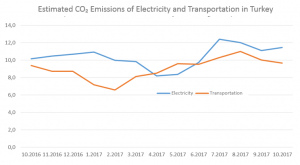 SUMMARY:
SUMMARY:
During a climate change debate, one side was talking about lignite plants, while the other was exclaiming “close the plants”. If Turkey’s emissions are to be viewed as a whole, then it should be considered that a significant portion of the measures should target transportation as well as electricity generation. But above all else, it should first be determined which source is responsible for how much of the emissions. Turkish Statistical Institute (TUIK) like Eurostat, combine the amount of emissions from transportation and energy under a single group called “energy” in its newsletters. This account fully immerses transportation within the energy sector. Even if all lignite power plants in Turkey were to be shut down, Turkey’s emissions will not fall more than 15%. With the increase in the petroleum demand, there has been some months in the last year where emissions from transportation has caught up with and surpassed electricity emission. The chief reason behind the rise in emission in Turkey in the last 2-3 years is the transportation sector. If this persists, no one will be able to topple transportation from its emission throne.
METHOD:
Multiple data sources were utilised in this study. Fuel oil and petroleum products consumption is taken from JODIDB.org. Since the fuel figures here are thousand barrels/day, the total emission for each month was calculated by multiplying by the number of days in that month. In emission factors, the US Environmental Protection Agency’s (EPA) emission factors were employed. Numbers from Deloitte’s “Linyit Kömürü Sahalarının Ekonomiye Kazandırılması” report were used for the emission stemming from electricity production in Turkey. And the electricity generation figures were derived from Energy Exchange Istanbul’s (EXIST) Transparency Platform.
The whole dataset can be accessed from this site.
ANALYSIS:
First, the emission from transportation (excluding petroleum products) was compared with that stemming from electricity generation in Turkey’s emission calculation. The emission of all petroleum products was discovered to be over 20% of the emission from electricity. Petroleum is also the main primary energy source in the 2016 equilibrium table.


Honing in on the sub – components specifically, domestic coal and transportation can be compared more comfortably. Diesel emissions were almost double the lignite emissions throughout the year. Emissions from diesel have also coasted above other electrical emissions (sum of imported coal and natural gas). The largest import based article in Turkey’s emissions is diesel.
The impact of shutting down all lignite plants in emission reduction, is almost identical to rendering the transport sector 30% energy efficient. Imported coal and natural gas constitute the remainder of electricity emissions.
CONCLUSION:
When working on energy issues, sometimes a very clear result is not so clear when numbers are revealed. As we stated in the previous Q reports, in Turkey, the driving force behind the energy sector and its emissions is the transportation and oil consumption. Turkey’s demand for oil has reached 1.2 mb/d, car ownership has increased significantly, and in fact, in the last 5 years, oil became the most rapidly increasing demand component.
The transportation emissions out performing electricity generation emissions this year in US should have been compared with its Turkish equivalent. In this Q report, it was examined, on a monthly basis, whether international sources and emissions stemming from electricity or the transport related emissions present a bigger problem. If emissions discussions are to be held fairly, discussions should reflect responsible sectors and primary resources.
One-third of Turkey’s emissions emanate from coal (lignite and imported coal), and 45% from transportation. It will be useful to pay attention to other emission items in the background when looking at coal-fired power plants in emission discussions.
